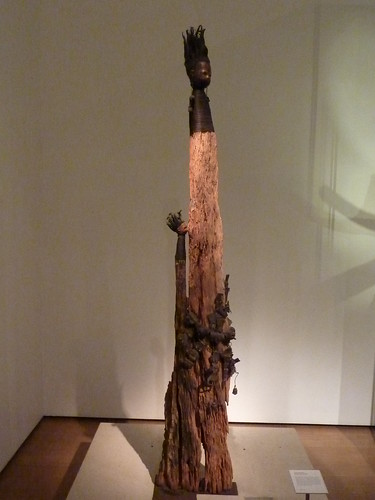The African gallery was interesting because it was a collection of old and contemporary African art. In the lecture we learnt about how Benin was a kingdom with natural resources of ivory and metals, which was one of the many things that attracted Britain to start trading with them. This eventually led to Britian and Europe trading guns for these resources, which led to the guns being introduced into and consequently destabilizing the culture. This didn't only happen in Benin, but many places in Africa. The 'Tree of Life' sculpture (picture below) in the gallery was influenced by the unrest and violence that took place Mozambique's civil war, during which millions of weapons entered the country. It is a symbol of hope and optimism, and connotes that good can grow out of the bad.

Information about the 'Tree of Life' from the British Museum:
"The Tree of Life was made by four Mozambican artists: Cristovao Canhavato (Kester), Hilario Nhatugueja, Fiel dos Santos and Adelino Serafim Maté. It is a product of the Transforming Arms into Tools (TAE) project and is made from decommissioned weapons.
TAE was set up by Bishop Dom Dinis Sengulane in 1995 and is supported by Christian Aid. During Mozambique's civil war, which lasted from 1976 to 1992, millions of guns and other weapons poured into the country and most of them remain hidden or buried in the bush. The project is an attempt to eliminate the threat presented by the hidden weapons. Mozambicans are encouraged to hand them over in exchange for items like ploughs, bicycles and sewing machines. In one case a whole village gave up its weapons in exchange for a tractor.
Once the weapons are decommissioned, they are cut up and turned into sculptures by the artists in Maputo. This process has produced the Tree of Life and the Throne of Weapons, also created by Kester."
Another piece that I really liked was 'Les Femme Peul' by Gerard Quenum, from the Republic of Benin, 2007 (picture below)

(click through for the source of the image)
"This sculpture is part of an ancient tradition of mother and child figures....Taller figure 'Mother of Society' - smaller figure representing an entire people. A memorial to the resilience and achievement of the Fulani people."
One of the things we were meant to look at and think about was to see how the different ways in which artefacts from non-British cultures are shown in museums. The way I saw it was that artefacts from non-British cultures, for example in the African gallery, seemed to be over-crowded and all put together in huge cabinets which made each individual item a little less special. Especially the objects such as the masks, which individually have sacred meanings or are used in certain rituals and/or celebrations. Many have opposite meanings or are used in completely different scenarios yet they are all put together. I found some a bit too high to look at in detail too - although that might be just because I'm short? I understand that there are so many pieces (e.g. weapons, textile pieces, masks etc) and the British Museum hasn't got all the space in the world to place each object in a place and context they deserve but I'm sure the people who made each object and the cultures they came from wouldn't want these pieces devalued solely by the way they were displayed?
I also found that in the Living and Dying Gallery, a lot of the non-British artefacts were displayed in slightly the same way, although there were less objects and more space in each cabinet. Whereas the British piece 'Cradle to Grave' was in the centre of the room at a height where all could look down at it in detail and walk around it - even though a lot of the other pieces in the cabinets from other culutres were less accessible. This may be because, at the end of the day, it is in the British Museum.

No comments:
Post a Comment